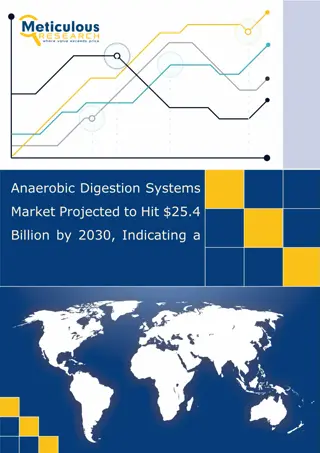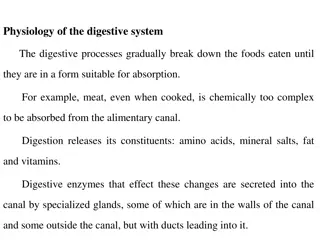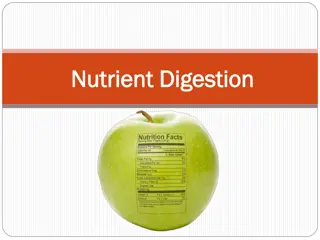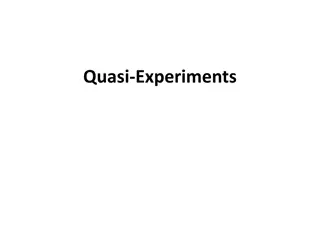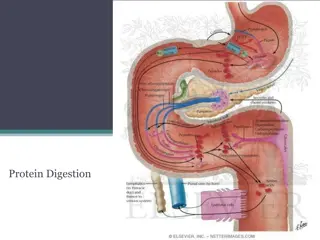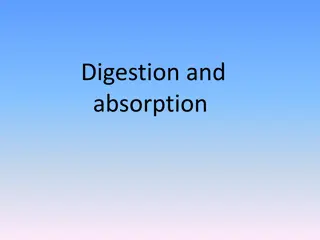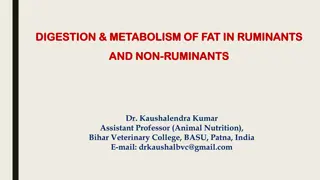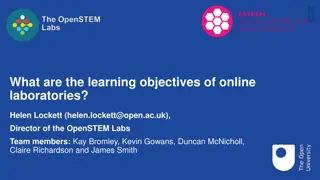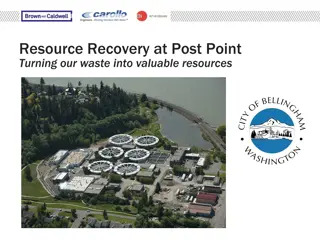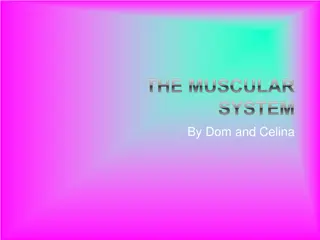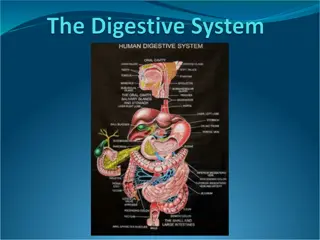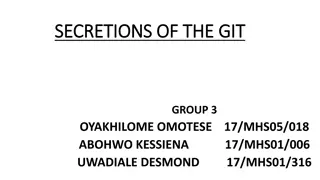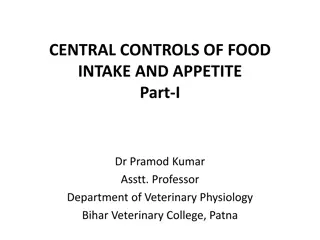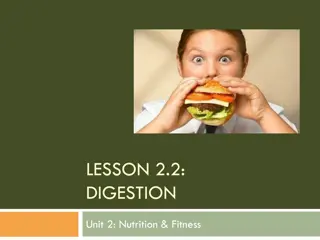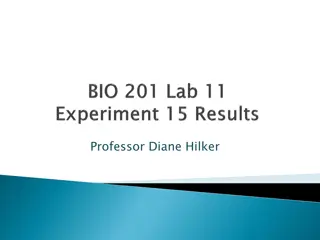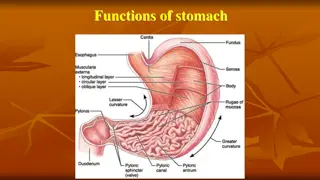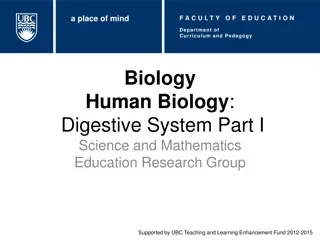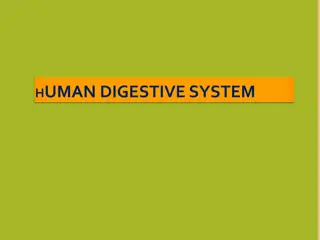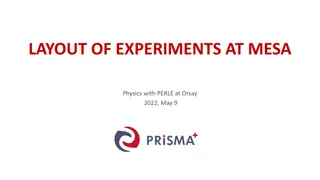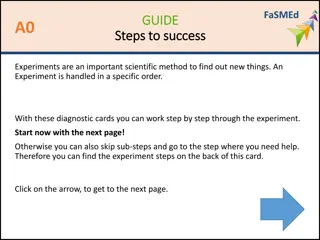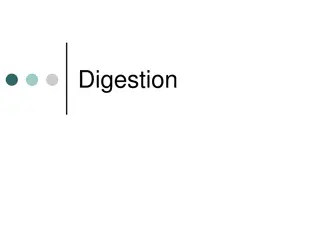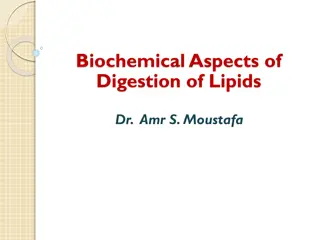Evaluation of feedstuffs by digestion experiments
The evaluation of feedstuffs through digestion experiments, including physical, chemical, and biological evaluations. It also discusses the measurement of digestibility and the different methods used for determining digestibility coefficients.
1 views • 49 slides
Understanding Mastication in Digestive System
Mastication is the process of cutting and grinding food to prepare it for digestion. This stage increases the surface area of food for efficient enzyme breakdown. The significance of mastication includes breaking down food into smaller particles, mixing with saliva, and enhancing taste. The chewing
1 views • 25 slides
Anaerobic Digestion Systems Market Projected to Hit $25.4 Billion by 2030
The increasing adoption of organic feedstock for biogas generation and the integration of advanced technologies into anaerobic digestion systems are expected to create market growth opportunities. However, the operational issues with anaerobic digestion systems are major challenges for the players o
0 views • 4 slides
Understanding the Digestive System Processes
The digestive system is responsible for the breakdown, absorption, and elimination of food. It involves processes such as ingestion, propulsion, mechanical and chemical digestion, absorption, and defecation. Starting from the mouth with salivary glands and oral cavity, it progresses through the esop
2 views • 38 slides
Anatomy of Intestine in Domestic Animals
The intestine in domestic animals plays a vital role in digestion and absorption. It consists of the small intestine for chemical digestion and absorption and the large intestine for water absorption and excretion. This article covers the gross anatomy, histology, and embryology of the intestine, de
2 views • 84 slides
Anaerobic Digestion Systems Market Projected to Reach $25.4 Billion by 2030
The anaerobic digestion systems market has been growing steadily in recent years due to increased awareness of the benefits of renewable energy, government incentives and regulations, and the rising cost of fossil fuels. Anaerobic digestion is a sustainable method of waste management and renewable e
0 views • 4 slides
Overview of Digestive System Physiology and Functions
The digestive system functions to break down food into absorbable forms through processes like ingestion, propulsion, digestion, absorption, and elimination. Specific organs and enzymes play key roles in these processes, ultimately providing nutrients for the synthesis of body constituents and energ
0 views • 13 slides
Comprehensive Overview of Protein Digestion in the Gastrointestinal Tract
Understanding the process of protein digestion is crucial for optimal nutrient absorption and overall health. In this lecture series by Professor Shraddha Singh, delve into the composition of proteins, the role of enzymes in protein digestion, sites of absorption, molecular basis of protein transpor
0 views • 28 slides
Understanding Digestion and Absorption in the Gastrointestinal Tract
Digestion and absorption in the gastrointestinal tract are crucial processes for breaking down carbohydrates, fats, and proteins into smaller compounds that can be absorbed by the body. Carbohydrates undergo hydrolysis to convert into monosaccharides, fats are broken down from triglycerides, and pro
1 views • 22 slides
Protein Digestion and Metabolism in Ruminants and Non-Ruminants
Digestion and metabolism of protein in both ruminants and non-ruminants involve enzymatic breakdown of proteins into polypeptides and amino acids in the stomach and intestines. Key enzymes such as pepsin, trypsin, and chymotrypsin play important roles in protein digestion. Gastric digestion in the s
1 views • 14 slides
Understanding Nutrient Digestion and Absorption Process
Nutrients in food provide essential materials and energy for our body to function. During digestion, large molecules are broken down into smaller pieces for absorption. Enzymes play a crucial role in this breakdown process, with each enzyme being specific to a certain type of nutrient. Carbohydrates
1 views • 14 slides
Understanding Quasi-Experiments in Research
Quasi-experiments are research studies that resemble experiments but do not involve random assignment of participants to treatment groups. This approach is taken when random assignment is challenging or when ethical considerations come into play. Unlike true experiments, quasi-experiments can provid
0 views • 15 slides
Investigating Amylase Activity in Starch Digestion
An investigation on amylase activity involving the digestion of starch was conducted, with methods for controlling temperature, calculating digestion rates, and improving data precision discussed. The effects of temperature on enzymatic activity and precision enhancement techniques were explored.
0 views • 47 slides
Understanding Lipids: Importance, Digestion, and Absorption
Professor Shraddha Singh's lecture series delves into the significance of lipids, the types of lipids, and the role of bile in digestion. Learn about saturated vs. unsaturated fatty acids, common fatty acids found in lipids, lipid structures, and properties. Explore the diverse types of fats we cons
2 views • 32 slides
Understanding Protein Digestion and Amino Acid Metabolism
The process of protein digestion involves proteolytic enzymes produced by the stomach, pancreas, and small intestine. Pepsinogen is activated to pepsin in the stomach, breaking down proteins into oligopeptides and amino acids. After absorption, amino acids are utilized for protein synthesis and as d
0 views • 7 slides
Understanding Gastric Motility and Secretion in the Stomach
The stomach plays a crucial role in food processing, acting as a reservoir, preparing chyme for digestion, and facilitating absorption. Divided anatomically and physiologically, it functions as a storage unit and mixing chamber for food. Key motor functions include storage, preparation for digestion
0 views • 49 slides
Overview of the Gastrointestinal System and Its Functions
The alimentary tract supplies the body with water, electrolytes, and nutrients through processes like movement of food, digestion, absorption, and circulation. The gastrointestinal tract, starting from the mouth to the anus, is aided by accessory organs for digestion. Functions include motility, sec
0 views • 29 slides
Understanding Carbohydrate Digestion and Absorption
Carbohydrate digestion begins in the mouth with the release of salivary amylase, continues in the stomach where chyme is formed, and is completed in the small intestine with the help of pancreatic enzymes. Absorption of the broken-down sugars occurs in the small intestine, while undigested carbohydr
2 views • 32 slides
Fat Digestion and Metabolism in Ruminants and Non-Ruminants
This article highlights the digestion and metabolism of fat in both ruminant and non-ruminant species. It explains the differences in lipid digestion in the stomach and small intestine of animals, focusing on the role of lipase, bile, and colipase in the breakdown of triglycerides. The process of mi
2 views • 19 slides
Carbohydrate Digestion and Metabolism in Ruminants and Non-Ruminants
Digestion and absorption of carbohydrates play a crucial role in the overall metabolism of ruminants and non-ruminants. This process involves various enzymes like amylase, maltase, lactase, and sucrase that break down complex carbohydrates into simpler forms for absorption in the small intestine. Ru
0 views • 17 slides
Advanced Fission Experiments at University of Michigan
The University of Michigan, under the guidance of Dr. Sara A. Pozzi, conducts cutting-edge fission experiments leveraging organic scintillation detectors. These detectors offer advantages such as nanosecond-scale response times, energy proportionality, and scalability. The experiments focus on impro
0 views • 4 slides
Understanding the Objectives of Online Laboratories in STEM Education
Online laboratories offer interactive experiments over the internet, providing remote and virtual practical experiences in STEM education. The OpenSTEM Labs project aims to explore various activities and outcomes in experiments, focusing on classification schemes and learning objectives. The purpose
0 views • 17 slides
Resource Recovery at Post Point: Turning Waste into Valuable Resources
Post Point WWTP is undergoing improvements to address the aging solids stream train incinerator and explore opportunities for resource recovery through anaerobic digestion. The project aims to recover resources, minimize social impacts, and meet climate action goals by utilizing biosolids and biogas
0 views • 24 slides
Understanding the Muscular System: Functions & Importance
Muscles are essential for movement, posture, circulation, and digestion in the human body. Without a properly functioning muscular system, vital processes like breathing and food digestion would be compromised. Maintaining muscle health through exercise and a nutritious diet is crucial to ensure opt
0 views • 11 slides
Understanding the Human Digestive System: A Comprehensive Overview
The digestive system plays a vital role in breaking down food into nutrients for absorption. This process involves stages like ingestion, digestion, absorption, and egestion. Beginning with the mouth, food moves through the esophagus, stomach, and small intestine for digestion and absorption of nutr
0 views • 21 slides
Understanding the Secretions of the Gastrointestinal Tract (GIT)
The gastrointestinal tract (GIT) is responsible for digestion, absorption, and secretion through various glands along the alimentary canal. Secretions are stimulated by factors like direct contact, nervous system activation, and hormonal regulation. Hormones released in response to food presence hel
0 views • 7 slides
Understanding the Central Controls of Food Intake and Appetite in Animals
Nutrition is essential for animal health and growth, with food nutrients being the main energy source through digestion and absorption processes. The regulation of animal nutrition involves various tissues and organs. Animals acquire nutrients through specialized digestive systems, breaking down foo
0 views • 14 slides
Understanding Digestion: A Journey Through the Digestive System
Dive into the fascinating world of digestion with a focus on the organs involved, processes like chewing and absorption, and the role of nutrients. Explore the journey of a pretzel through the digestive system and learn about key concepts such as the functions of the mouth, pharynx, esophagus, stoma
0 views • 12 slides
Microbiology Laboratory Experiments Overview
This overview showcases various microbiology laboratory experiments conducted to examine the physiology of bacteria, enzymatic activities, and biochemical reactions. It includes experiments on Phenol Red Dextrose Broth, Phenol Red Lactose Broth, Nitrate Broth, Tryptone Broth, and more. The provided
0 views • 26 slides
Functions and Secretions of the Stomach
The stomach plays crucial roles in digestion through its secretions such as stomach juice, hydrochloric acid, and mucus. These secretions aid in breaking down food components, promoting optimal enzymatic activity, and providing a protective barrier against bacteria. The stomach juice is composed of
0 views • 8 slides
Understanding the Human Digestive System: Physical and Chemical Processes Explored
Explore the intricate workings of the human digestive system, focusing on both physical and chemical digestion processes. Learn about the structures involved, such as the mouth, stomach, and small intestine, and their roles in breaking down food for absorption. Discover how organs like the liver and
0 views • 13 slides
Exploring the Human Digestive System: Major Organs and Functions
The human digestive system is a complex network of organs working together to break down food into smaller molecules for absorption. It consists of major organs like the mouth, esophagus, stomach, small intestine, and large intestine, along with accessory organs such as the liver, gallbladder, and p
0 views • 34 slides
Overview of Small Intestine Histology and Function
The small intestine is a key organ in the digestive system responsible for the digestion and absorption of nutrients. It is divided into the duodenum, jejunum, and ileum, each with specific functions and structures like plicae circulares, villi, microvilli, and crypts of Lieberkühn. The intestinal
0 views • 14 slides
Latest Developments in Physics Experiments at MESA Orsay 2022
Developments at MESA include the layout of experiments, status of the 5 MeV Injector, operational modes, fixed target experiments, challenges in the EB-Experiment P2, procurement updates, energy recovery mode in MAGIX, and upcoming spectrometer deliveries. Exciting advancements and projects are unde
0 views • 16 slides
Understanding Multi-Stage Probability Experiments
Explore single-stage and multi-stage probability experiments in contemporary mathematics. Learn how to determine sample spaces of experiments using tree diagrams, tables, and outcomes. Discover the concepts of independence and dependence between stages in multi-stage experiments through practical ex
0 views • 18 slides
Insights into Mass Hierarchy Determination in Long-Baseline Neutrino Experiments
Combining appearance probabilities of electron and anti-electron neutrinos in long-baseline experiments can help determine the mass hierarchy, with ongoing experiments collecting significant data by 2020. Analyses point to CP violation possibilities, with updates expected in Neutrino2016. The capabi
0 views • 6 slides
Steps to Success: Conducting Scientific Experiments
Scientific experiments play a crucial role in discovering new things. Follow a specific order of steps outlined in the guide to successfully conduct experiments. Begin by understanding biological phenomena, formulating hypotheses, planning, performing experiments, observing results, and drawing conc
0 views • 29 slides
Understanding Digestion Process in the Gut
Learn about the intricate process of digestion that takes place within the gut. Explore how food is broken down, absorbed, and transformed into essential nutrients for the body, with a focus on the small intestine's role in absorption. Discover the importance of enzymes, absorption, and waste elimin
0 views • 58 slides
Understanding Cholethiasis and Gallstones: A Comprehensive Guide
Bile, produced in the liver, helps in fat digestion and is composed of various substances. Bile acids are essential for digestion and are categorized as primary and secondary bile acids. The gallbladder stores and releases bile, aiding in fat digestion. Gallstones are solid materials that form in th
0 views • 20 slides
Biochemical Aspects of Lipid Digestion by Dr. Amr S. Moustafa
This lecture by Dr. Amr S. Moustafa covers the biochemical aspects of lipid digestion, including the process, organs involved, enzymes required, and end products. It discusses the assembly, metabolism, and fate of chylomicrons, as well as the clinical manifestations of diseases related to defective
0 views • 31 slides





